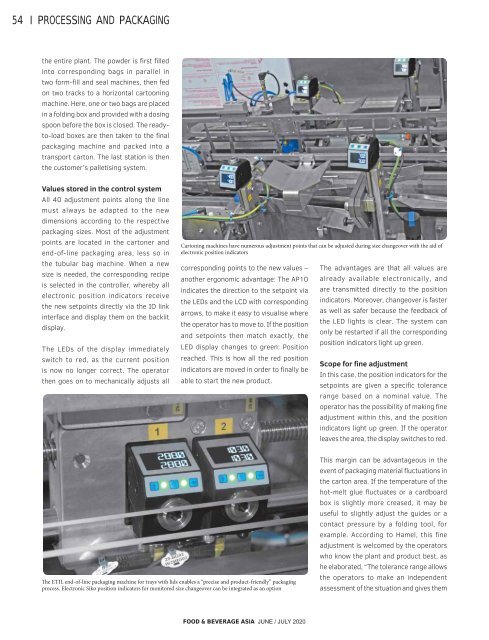Food & Beverage Asia June/July 2020
Food & Beverage Asia (FBA) is the leading source of food and beverage news in Asia since 2002. FBA delivers a comprehensive view of the food and beverage landscape, spanning across the latest health and nutrition trends and industry innovations in ingredients, recipe formulations, food science, sustainability, packaging, and automation, as well as advancements in agri and food-tech.
Food & Beverage Asia (FBA) is the leading source of food and beverage news in Asia since 2002. FBA delivers a comprehensive view of the food and beverage landscape, spanning across the latest health and nutrition trends and industry innovations in ingredients, recipe formulations, food science, sustainability, packaging, and automation, as well as advancements in agri and food-tech.
Create successful ePaper yourself
Turn your PDF publications into a flip-book with our unique Google optimized e-Paper software.
54<br />
PROCESSING AND PACKAGING<br />
the entire plant. The powder is first filled<br />
into corresponding bags in parallel in<br />
two form-fill and seal machines, then fed<br />
on two tracks to a horizontal cartooning<br />
machine. Here, one or two bags are placed<br />
in a folding box and provided with a dosing<br />
spoon before the box is closed. The readyto-load<br />
boxes are then taken to the final<br />
packaging machine and packed into a<br />
transport carton. The last station is then<br />
the customer’s palletising system.<br />
Values stored in the control system<br />
All 40 adjustment points along the line<br />
must always be adapted to the new<br />
dimensions according to the respective<br />
packaging sizes. Most of the adjustment<br />
points are located in the cartoner and<br />
end-of-line packaging area, less so in<br />
the tubular bag machine. When a new<br />
size is needed, the corresponding recipe<br />
is selected in the controller, whereby all<br />
electronic position indicators receive<br />
the new setpoints directly via the IO link<br />
interface and display them on the backlit<br />
display.<br />
The LEDs of the display immediately<br />
switch to red, as the current position<br />
is now no longer correct. The operator<br />
then goes on to mechanically adjusts all<br />
Cartoning machines have numerous adjustment points that can be adjusted during size changeover with the aid of<br />
electronic position indicators<br />
corresponding points to the new values –<br />
another ergonomic advantage: The AP10<br />
indicates the direction to the setpoint via<br />
the LEDs and the LCD with corresponding<br />
arrows, to make it easy to visualise where<br />
the operator has to move to. If the position<br />
and setpoints then match exactly, the<br />
LED display changes to green: Position<br />
reached. This is how all the red position<br />
indicators are moved in order to finally be<br />
able to start the new product.<br />
The advantages are that all values are<br />
already available electronically, and<br />
are transmitted directly to the position<br />
indicators. Moreover, changeover is faster<br />
as well as safer because the feedback of<br />
the LED lights is clear. The system can<br />
only be restarted if all the corresponding<br />
position indicators light up green.<br />
Scope for fine adjustment<br />
In this case, the position indicators for the<br />
setpoints are given a specific tolerance<br />
range based on a nominal value. The<br />
operator has the possibility of making fine<br />
adjustment within this, and the position<br />
indicators light up green. If the operator<br />
leaves the area, the display switches to red.<br />
The ETIL end-of-line packaging machine for trays with lids enables a “precise and product-friendly” packaging<br />
process. Electronic Siko position indicators for monitored size changeover can be integrated as an option<br />
This margin can be advantageous in the<br />
event of packaging material fluctuations in<br />
the carton area. If the temperature of the<br />
hot-melt glue fluctuates or a cardboard<br />
box is slightly more creased, it may be<br />
useful to slightly adjust the guides or a<br />
contact pressure by a folding tool, for<br />
example. According to Hamel, this fine<br />
adjustment is welcomed by the operators<br />
who know the plant and product best, as<br />
he elaborated, “The tolerance range allows<br />
the operators to make an independent<br />
assessment of the situation and gives them<br />
FOOD & BEVERAGE ASIA JUNE / JULY <strong>2020</strong>


















